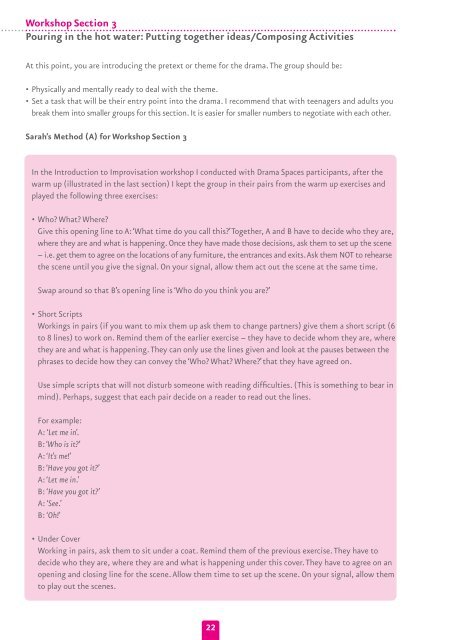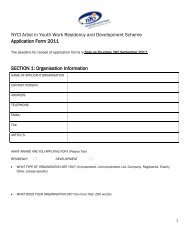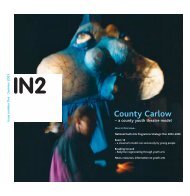DRAMA SPACES - Youth Arts Programme
DRAMA SPACES - Youth Arts Programme
DRAMA SPACES - Youth Arts Programme
You also want an ePaper? Increase the reach of your titles
YUMPU automatically turns print PDFs into web optimized ePapers that Google loves.
dramaspaces6 18/8/05 4:25 PM Page 22Workshop Section 3Pouring in the hot water: Putting together ideas/Composing ActivitiesAt this point, you are introducing the pretext or theme for the drama.The group should be:• Physically and mentally ready to deal with the theme.• Set a task that will be their entry point into the drama. I recommend that with teenagers and adults youbreak them into smaller groups for this section. It is easier for smaller numbers to negotiate with each other.Sarah’s Method (A) for Workshop Section 3In the Introduction to Improvisation workshop I conducted with Drama Spaces participants, after thewarm up (illustrated in the last section) I kept the group in their pairs from the warm up exercises andplayed the following three exercises:• Who? What? Where?Give this opening line to A:‘What time do you call this?’Together, A and B have to decide who they are,where they are and what is happening. Once they have made those decisions, ask them to set up the scene– i.e. get them to agree on the locations of any furniture, the entrances and exits.Ask them NOT to rehearsethe scene until you give the signal. On your signal, allow them act out the scene at the same time.Swap around so that B’s opening line is ‘Who do you think you are?’• Short ScriptsWorkings in pairs (if you want to mix them up ask them to change partners) give them a short script (6to 8 lines) to work on. Remind them of the earlier exercise – they have to decide whom they are, wherethey are and what is happening.They can only use the lines given and look at the pauses between thephrases to decide how they can convey the ‘Who? What? Where?’that they have agreed on.Use simple scripts that will not disturb someone with reading difficulties. (This is something to bear inmind). Perhaps, suggest that each pair decide on a reader to read out the lines.For example:A: ‘Let me in’.B: ‘Who is it?’A: ‘It’s me!’B: ‘Have you got it?’A: ‘Let me in.’B: ‘Have you got it?’A: ‘See.’B: ‘Oh!’• Under CoverWorking in pairs, ask them to sit under a coat. Remind them of the previous exercise.They have todecide who they are, where they are and what is happening under this cover.They have to agree on anopening and closing line for the scene.Allow them time to set up the scene. On your signal, allow themto play out the scenes.22






